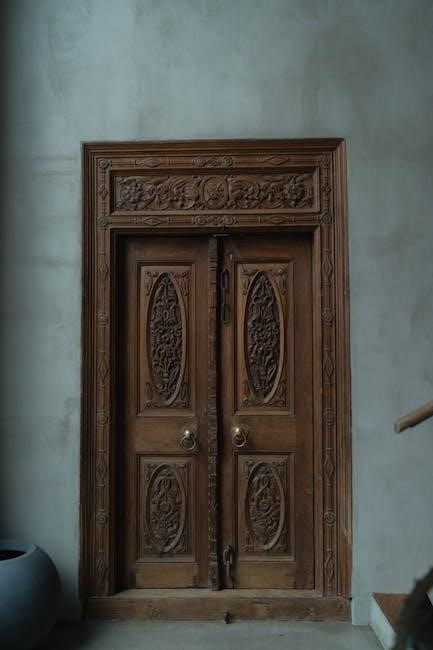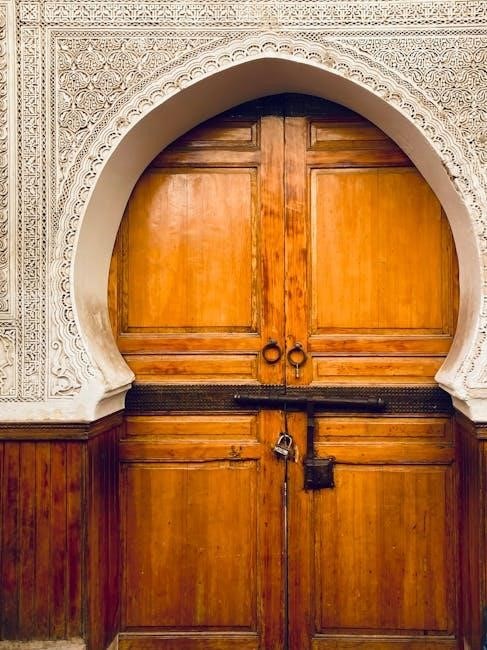Debussy’s Arabesque No. 1, composed in 1888, is a captivating piece known for its dreamy, flowing melodies and delicate ornamentation. It showcases Debussy’s early exploration of tonal experimentation, blending simplicity with intricate harmonies. The work is part of a set of two Arabesques, reflecting Debussy’s fascination with Middle Eastern musical influences. Arabesque No. 1 remains a cornerstone of the piano repertoire, celebrated for its evocative and lyrical qualities. Its availability in PDF format has made it accessible for study and performance, preserving its timeless beauty for future generations.
1.1 Historical Context of the Composition
Debussy’s Arabesque No. 1 was composed in 1888, during a period of significant musical innovation in Europe. The late 19th century saw composers exploring exoticism and impressionism, influences that are evident in this piece. Debussy, in his early 20s, was beginning to develop his unique style, blending Middle Eastern musical elements with Western techniques. The Arabesque reflects this blend with its delicate, flowing melodies and unconventional use of tonality. The piece was well-received, showcasing Debussy’s emerging talent and contributing to his reputation as a leading figure in the transition from Romanticism to Modernism. Its historical significance lies in its early manifestation of impressionistic ideals.
1.2 Significance of the Arabesque in Debussy’s Work
Debussy’s Arabesque No. 1 holds a pivotal role in his oeuvre, marking an early exploration of impressionistic techniques. Composed in 1888, it reflects his growing interest in non-Western musical influences, particularly Middle Eastern motifs. The piece showcases his ability to blend delicate, flowing melodies with unconventional tonal structures, setting the stage for his later, more experimental works. As part of a set of two Arabesques, it demonstrates Debussy’s departure from traditional Romanticism, embracing a more fluid and expressive compositional style. This work not only highlights his technical skill but also foreshadows the innovative approaches that would define his career, making it a cornerstone of his early artistic development.
Structure and Composition of Arabesque No. 1
Arabesque No. 1 features flowing arpeggios in E major, with a loose A-B-A structure. Its impressionistic style emphasizes timbre and texture, creating a dreamy, evocative atmosphere.
2.1 Musical Form and Structure
Debussy’s Arabesque No. 1 is structured in a loose A-B-A ternary form, with flowing arpeggios in E major dominating the A sections. The B section introduces a contrasting theme in C major, marked by a more contemplative and lyrical character. The piece features a dreamy, improvisatory quality, with rubato passages and nuanced pedaling instructions that enhance its ethereal texture. The structure is characterized by a seamless flow of motifs, creating a sense of continuity despite the contrasting moods. This form allows for expressive freedom, making it a hallmark of Debussy’s early impressionistic style. The PDF score highlights these structural elements clearly, aiding in interpretation and performance.
2.2 Key and Tempo Analysis
Debussy’s Arabesque No. 1 is written in the key of E major, with a tempo marking of Andantino con moto, creating a flowing, wavelike movement. The piece begins with a gentle, lilting rhythm in the right hand, accompanied by soft arpeggios in the left. Modulations to C major and other keys add harmonic richness, while maintaining the dreamy, evocative quality. The tempo remains steady, allowing for expressive rubato passages that enhance the piece’s lyrical character. Dynamics are subtle, ranging from pianissimo to mezzo-forte, with careful attention to phrasing and articulation. The PDF score provides clear markings for tempo, dynamics, and pedaling, ensuring accurate interpretation of Debussy’s intent.
2.3 Use of Motifs and Themes
Debussy’s Arabesque No. 1 is characterized by the intricate development of motifs and themes, creating a sense of fluidity and continuity. The main motif, introduced in the right hand, is a delicate, flowing pattern that recurs throughout the piece, undergoing subtle variations in rhythm, harmony, and dynamics. A secondary theme emerges in the relative minor, adding contrast and depth. Debussy masterfully interweaves these motifs, often overlapping them to create a seamless texture. The PDF score highlights these thematic developments, showcasing Debussy’s innovative approach to musical structure. This interplay of motifs and themes gives the Arabesque its dreamlike quality, making it a cornerstone of Impressionist piano repertoire.
Performance Techniques for Arabesque No. 1
Performance of Arabesque No. 1 requires precise pedaling, nuanced dynamics, and expressive articulation. Pianists must master delicate fingerings and maintain a flowing, ethereal quality throughout the piece.
3.1 Pianistic Requirements and Challenges
Performing Debussy’s Arabesque No. 1 demands exceptional technical skill and artistic sensitivity. Pianists must navigate complex fingerings, delicate arpeggios, and intricate pedaling techniques. The piece requires precise control over dynamics, ranging from soft, ethereal passages to more dramatic crescendos. Ornamentation and rubato add layers of expressiveness, challenging performers to maintain a fluid, natural flow. Additionally, the unpredictable harmonic shifts and tonal experimentation characteristic of Debussy’s style demand a deep understanding of the composer’s intent. Mastery of these elements ensures a captivating interpretation of this beloved piece.
3;2 Pedaling Techniques
Debussy’s Arabesque No. 1 requires masterful use of pedaling to achieve its signature ethereal and fluid sound. The sustain pedal is essential for creating legato passages and blending harmonies, while the una corda pedal softens delicate sections. The sostenuto pedal is occasionally used to sustain specific voices, adding depth. Pianists must carefully balance pedaling to avoid muddying the texture, especially in complex arpeggiated sections. Partial pedaling and quick releases are necessary to maintain clarity. Debussy’s nuanced markings guide pedal usage, but interpreters often refine techniques to enhance the piece’s dreamlike quality. Proper pedaling transforms the Arabesque into a captivating auditory experience, showcasing the pianist’s technical and expressive mastery.
3.4 Interpretation and Expression
Interpreting Debussy’s Arabesque No. 1 demands a deep connection to its dreamy, evocative nature. Pianists must balance dynamics, phrasing, and rubato to convey the piece’s fluid, improvisatory feel. The music’s delicate, flowing passages require a light, articulate touch, while its contemplative moments call for expressive restraint. Tempo should be flexible, allowing for subtle fluctuations that enhance the music’s lyrical quality. The pianist’s interpretation should capture the interplay of light and shadow, creating a mesmerizing auditory experience. By embracing Debussy’s unique style, performers can bring this timeless work to life with emotion and nuance, ensuring its beauty resonates with modern audiences.
The PDF Version of Arabesque No. 1
The PDF version of Debussy’s Arabesque No. 1 offers a clear, accessible format for pianists to study and perform the piece. It preserves the original composition’s integrity, ensuring precise notation and layout for optimal readability. Musicians can easily download and print the score, making it a convenient resource for practice and performance. The PDF format also allows for digital annotation, enabling deeper analysis and interpretation of Debussy’s intricate harmonies and phrasing. This version is widely available online, providing global access to one of Debussy’s most beloved works.

4.1 Features of the PDF Score

The PDF score of Debussy’s Arabesque No. 1 provides a high-quality, digital representation of the original composition. It features clear notation, proper layout, and precise musical markings, ensuring accuracy for pianists. The score maintains the integrity of Debussy’s work, with detailed dynamics, tempo markings, and articulations. The PDF format allows for easy zooming and viewing on various devices, making it ideal for both study and performance. Additionally, the score often includes measure numbers and fingerings, aiding musicians in navigation and technique. Its digital nature also enables annotations, facilitating personalized practice and interpretation. Overall, the PDF score is a reliable and accessible resource for mastering this beloved piece.
4.2 Benefits of Using a Digital Score
Using a digital score of Debussy’s Arabesque No. 1 offers numerous advantages for pianists and educators. Portability is a key benefit, as the PDF can be easily stored on devices like tablets or laptops, allowing access anywhere. Digital scores also enable customization, such as adjusting font sizes for readability or adding annotations for personal interpretation. Additionally, digital versions eliminate the risk of physical damage and provide instant access to backups. They are cost-effective, often more affordable than physical copies, and reduce clutter. Furthermore, digital scores promote environmental sustainability by minimizing paper use. Overall, they enhance convenience, accessibility, and flexibility for both practice and performance.
4.3 Where to Find the PDF Version
The PDF version of Debussy’s Arabesque No. 1 can be found through various online platforms and music repositories. Official composer websites, digital sheet music stores, and educational resources often provide high-quality scans. Platforms like the International Music Score Library Project (IMSLP) offer free access to public domain works, including Debussy’s Arabesque. Additionally, online marketplaces such as Musicnotes and Sheet Music Plus offer downloadable PDF versions for purchase. Universities and libraries may also provide access to digital scores through their databases. Ensure that the source is reputable to guarantee accuracy and legality. Purchasing from official sources supports the creators and ensures you receive a precise and well-formatted edition of the piece.

Historical Background of the Arabesque
The Arabesque originated in Middle Eastern music, characterized by intricate ornamentation and flowing rhythms. It influenced Western classical music, particularly in the Romantic era, inspiring composers like Debussy.
5.1 Origins of the Arabesque in Music
The Arabesque in music traces its roots to Middle Eastern and North African traditions, characterized by intricate, flowing melodic lines and ornamental details. The term “arabesque” refers to a decorative, curvilinear design in art, which translates musically into complex, interwoven patterns. In Western classical music, the Arabesque gained prominence during the Romantic era, as composers sought exotic inspiration. Debussy, influenced by these traditions, incorporated Arabesque elements into his works, blending them with French musical sensibilities. The Arabesque’s fluid, improvisatory nature and ornamental richness became a hallmark of his compositional style, as seen in Arabesque No. 1.
5.2 Debussy’s Influence from Middle Eastern Music
Debussy’s Arabesque No. 1 reflects his fascination with Middle Eastern musical traditions, particularly their use of intricate ornamentation and flowing melodic lines. During the 1889 Paris Exposition, Debussy was exposed to Javanese gamelan music, which deeply influenced his compositional style. He incorporated elements like unconventional scales, tonal experimentation, and rhythmic complexity into his work. The Arabesque’s dreamy, improvisatory quality mirrors the expressive freedom of Middle Eastern music. Debussy’s blending of these exotic influences with French musical aesthetics created a unique sound, as seen in the delicate, ornamental passages of Arabesque No. 1, making it a landmark piece in the intersection of Western and Eastern musical traditions.
5.3 Evolution of the Arabesque in Western Classical Music
The Arabesque evolved significantly in Western classical music, transitioning from a Baroque-era vocal ornamentation technique to a sophisticated instrumental form. By the Romantic era, composers like Chopin and Liszt incorporated arabesque-like flourishes for expressive effect. Debussy’s Arabesque No. 1 marked a turning point, blending Middle Eastern influences with Western harmonies. Its flowing, improvisatory style redefined the arabesque, emphasizing tonal experimentation and lyrical freedom. This piece bridged traditional techniques with exotic elements, inspiring later composers to explore similar fusions. The Arabesque’s evolution reflects the dynamic interplay between Western musical traditions and global influences, as seen in Debussy’s innovative approach to the form.

Cultural Impact of Arabesque No. 1
Debussy’s Arabesque No. 1 has left an indelible mark on culture, inspiring countless adaptations in film, media, and modern music, while remaining a beloved piece for pianists worldwide.
6.1 Reception at the Time of Premiere

Debussy’s Arabesque No. 1 premiered in 1888, receiving mixed reactions due to its unconventional style. Critics noted its departure from traditional forms, with some praising its innovation while others found it perplexing. The piece’s dreamy, flowing melodies and delicate ornamentation captivated audiences, showcasing Debussy’s early exploration of tonal experimentation. Despite initial skepticism, the Arabesque No. 1 gradually gained recognition for its lyrical beauty and harmonic richness, marking a significant step in Debussy’s development as a composer. Its premiere highlighted the emerging impressionist movement, challenging classical norms and paving the way for modern musical expression.
6.2 Influence on Modern Music
Debussy’s Arabesque No. 1 has profoundly influenced modern music, inspiring composers and musicians across genres. Its unconventional use of scales, tonalities, and rhythms laid the groundwork for impressionist and contemporary styles. The piece’s flowing arpeggios and delicate textures have been adapted in jazz improvisation, ambient electronica, and film scores. Many modern pianists and composers draw inspiration from its lyrical simplicity and harmonic innovation. The PDF version of the score has further facilitated its study and adaptation, ensuring its influence continues to resonate in today’s musical landscape. Debussy’s Arabesque remains a timeless bridge between classical tradition and modern experimentation.
6.3 Use in Popular Culture
Debussy’s Arabesque No. 1 has become a staple in popular culture, frequently featured in films, television shows, and commercials. Its ethereal and evocative qualities make it a favorite for creating emotional depth in various media. The piece has been used in movies like The Painted Veil and The Others, as well as in numerous advertisements and documentaries. Its delicate, flowing melodies have also been sampled in electronic and ambient music, further broadening its reach. The accessibility of the PDF score has made it easier for creators to incorporate this timeless work into their projects, ensuring its continued relevance in modern media and entertainment.

Educational Resources for Learning Arabesque No. 1
Educational resources for Debussy’s Arabesque No. 1 include PDF scores, tutorial videos, and practice guides, aiding pianists in mastering the piece’s intricate details and expressive qualities.
7.1 Sheet Music and PDF Resources
Sheet music and PDF resources for Debussy’s Arabesque No. 1 are widely available online, offering pianists access to high-quality scores. Platforms like Musicnotes, Sheet Music Plus, and the International Music Score Library Project (IMSLP) provide downloadable PDF versions of the piece. These resources often include annotations, fingerings, and performance notes, aiding interpretation. Many websites offer free or affordable options, making the piece accessible to students and professionals alike. The PDF format ensures clarity and convenience, allowing musicians to print or view the score on digital devices. Additionally, some editions include historical context or analytical insights, enhancing the learning experience for those studying Debussy’s work.
7.2 Tutorial Videos and Guides
Tutorial videos and guides for Debussy’s Arabesque No. 1 are invaluable resources for pianists seeking to master the piece. Platforms like YouTube and specialized music websites offer detailed video tutorials, breaking down complex sections and providing insights into technique and interpretation. Many guides focus on specific challenges, such as pedaling, dynamics, and phrasing, while others explore the historical and stylistic context of the work. Additionally, some tutorials include practice tips, helping pianists to approach the piece systematically. These resources complement the PDF scores, offering a visual and auditory learning experience. They are particularly useful for students and self-taught musicians aiming to refine their performance and deepen their understanding of Debussy’s unique style.
7.3 Practice Tips for Pianists
Mastering Debussy’s Arabesque No. 1 requires a focused and nuanced approach. Begin by practicing slowly, emphasizing precise finger placement and control. Pay attention to dynamics and phrasing, as these elements are crucial for capturing the piece’s ethereal quality. Break the composition into smaller sections, such as the opening motif or the middle section, and gradually combine them. Use a metronome to establish a steady tempo, particularly in the more intricate passages. Experiment with pedaling techniques to achieve the desired tonal clarity and sustain. Additionally, practice hands separately to refine articulation and dexterity. Finally, immerse yourself in the expressive qualities of the music, allowing your interpretation to shine through. Regular, deliberate practice will help you unlock the piece’s full beauty and complexity.

Modern Adaptations and Arrangements
Debussy’s Arabesque No. 1 has inspired modern adaptations, including orchestral arrangements, jazz interpretations, and electronic remixes, each offering fresh perspectives on the original piece’s timeless beauty.
8.1 Orchestral Arrangements
Debussy’s Arabesque No. 1 has been beautifully reimagined in orchestral arrangements, expanding its delicate piano texture into a rich, layered soundscape. These arrangements often feature lush strings, woodwind flourishes, and subtle percussion, capturing the piece’s ethereal essence while adding depth. Orchestral versions highlight the composition’s versatility, transforming its intimate piano origins into a grand, immersive experience. Conductors and arrangers carefully preserve the original’s dreamy, flowing quality, ensuring the arabesque’s signature motifs shine through. Such adaptations not only broaden the work’s appeal but also demonstrate its timeless allure, making it accessible to audiences in new and innovative ways while staying true to Debussy’s artistic vision.
8.2 Jazz and Contemporary Interpretations
Debussy’s Arabesque No. 1 has inspired numerous jazz and contemporary reinterpretations, showcasing its timeless appeal. Jazz musicians often infuse the piece with improvisational elements, blending its flowing melodies with syncopated rhythms and harmonic experimentation. Contemporary artists have reimagined the Arabesque using electronic instruments, looping techniques, and experimental production methods, creating fresh, modern soundscapes while preserving its ethereal essence. These interpretations highlight the versatility of Debussy’s composition, allowing it to transcend traditional classical boundaries. By merging the original’s delicate charm with modern musical styles, these adaptations introduce the Arabesque to new audiences, ensuring its relevance in the evolving landscape of music.
8.3 Electronic and Experimental Versions
Debussy’s Arabesque No. 1 has been reimagined in electronic and experimental forms, offering fresh perspectives on its timeless beauty. Artists have incorporated synthesizers, digital effects, and looping techniques to create ambient, modern interpretations. These versions often emphasize the piece’s dreamy, ethereal qualities, transforming it into a soundscape of contemporary electronica. Experimental arrangements may deconstruct the original melody, layering it with industrial or glitch elements, pushing the boundaries of classical music. Despite these radical transformations, the essence of Debussy’s Arabesque remains intact, proving its adaptability to modern artistic visions. These interpretations not only honor the original but also introduce it to new audiences in innovative ways.
The Role of Arabesque No. 1 in Music Education
Debussy’s Arabesque No. 1 is a cornerstone in music education, teaching students impressionistic techniques, nuanced pedaling, and expressive phrasing. Its availability in PDF enhances accessibility for study and performance, making it an invaluable resource for developing pianistic skills and understanding early 20th-century music.
9.1 Teaching the Piece to Students
Teaching Debussy’s Arabesque No. 1 to students is a rewarding experience, as it introduces them to impressionistic techniques and expressive playing. The piece is ideal for intermediate pianists, offering challenges in phrasing, pedaling, and dynamics. Educators often break the piece into sections, focusing on hand position, finger dexterity, and nuanced articulation. The availability of the PDF score allows students to analyze the composition digitally, highlighting key motifs and harmonic shifts. Teachers emphasize the importance of maintaining a steady tempo while conveying the dreamy, flowing quality of the music. Additionally, discussions on Debussy’s historical context and stylistic influences enrich the learning process, helping students connect with the piece on a deeper level.
9.2 Analyzing the Score for Educational Purposes
Analyzing Debussy’s Arabesque No. 1 from its PDF score is a valuable educational tool, offering insights into harmonic innovation and expressive techniques. Educators often focus on the piece’s unconventional tonal structures, emphasizing how Debussy employs whole-tone scales and modal interchange to create its distinctive sound. The score’s detailed phrasing, dynamics, and pedaling markings provide a roadmap for understanding the composer’s intent. Students can trace recurring motifs, such as the flowing arpeggio patterns, and explore how they evolve throughout the piece. Additionally, the PDF format allows for easy highlighting and annotation, making it an interactive resource for teaching harmony, texture, and performance practice; This analytical approach deepens students’ appreciation of Debussy’s groundbreaking style.
9.3 Incorporating the Piece into Curriculum
Debussy’s Arabesque No. 1 is a versatile piece for music education, suitable for various curriculum levels. Educators can integrate it into courses on music history, theory, and performance. The piece’s accessibility makes it ideal for high school students exploring impressionism, while its complexity challenges advanced undergraduates; Teachers can use the PDF score to analyze harmonic innovation, phrasing, and pedaling techniques. Assignments might include performing the piece, composing variations, or comparing it to Debussy’s later works. Its inclusion fosters a deeper understanding of early 20th-century music and encourages students to explore expressive interpretation. This curriculum integration enriches students’ musical knowledge and technical skills, making it a valuable educational resource.
Debussy’s Arabesque No. 1 remains a timeless masterpiece, cherished for its beauty and historical significance. The PDF version ensures its accessibility for future generations to study and appreciate.
10.1 Summary of Key Points

Debussy’s Arabesque No. 1 is a landmark piece in piano literature, blending lyrical melodies with innovative harmonies. Composed in 1888, it reflects Debussy’s early exploration of tonal experimentation and Middle Eastern influences. The piece is celebrated for its dreamy, flowing quality and delicate ornamentation, making it a cornerstone of the repertoire. Its availability in PDF format has enhanced accessibility for pianists and scholars, ensuring its preservation and study. The work’s significance lies in its historical context, structural elegance, and emotional depth, solidifying its place in both classical music education and performance. Its timeless beauty continues to inspire musicians and audiences alike.
10.2 Final Thoughts on the Significance of Arabesque No. 1
Debussy’s Arabesque No. 1 remains a timeless masterpiece, captivating audiences with its ethereal beauty and emotional depth. Its significance lies in its ability to bridge tradition and innovation, offering a glimpse into Debussy’s evolving style. The piece’s delicate balance of simplicity and complexity makes it a cornerstone of piano repertoire, inspiring generations of musicians. Its availability in PDF format ensures accessibility for study and performance, preserving its legacy for future artists and enthusiasts. Arabesque No. 1 not only reflects Debussy’s artistic genius but also continues to influence modern music, solidifying its place as a foundational work in classical music history.
